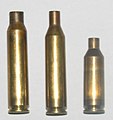
This is a table of selected pistol/submachine gun and rifle/machine gun cartridges by common name. Data values are the highest found for the cartridge, and might not occur in the same load.

The .223 Remington is a rimless, bottlenecked, centerfire intermediate cartridge. It was developed in 1957 by Remington Arms and Fairchild Industries for the U.S. Continental Army Command of the United States Army as part of a project to create a small-caliber, high-velocity firearm. The .223 Remington is considered one of the most popular common-use cartridges and is currently used by a wide range of semi-automatic and manual-action rifles.
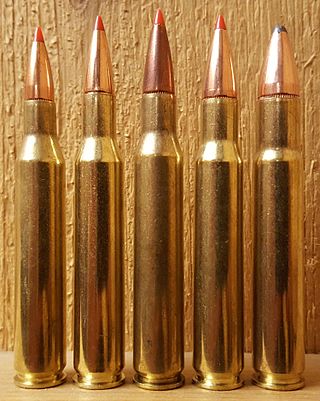
The .270 Winchester is a rifle cartridge developed by Winchester Repeating Arms Company in 1923, and it was unveiled in 1925 as a chambering for their bolt-action Model 54 to become arguably the flattest shooting cartridge of its day, only competing with the .300 Holland & Holland Magnum, also introduced in the same year.
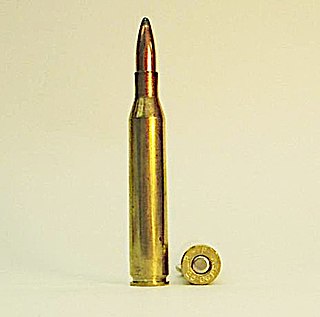
Considered by many as the most balanced of the "quarter bores" for hunting medium-sized game, the .25-06 Remington remained in obscurity as a wildcat cartridge for nearly half a century before being standardized by Remington in 1969.
The .204 Ruger is a centerfire rifle cartridge developed by Hornady and Ruger. At the time of its introduction in 2004, the .204 Ruger was the second-highest velocity commercially produced ammunition and the only centerfire cartridge produced commercially for bullets of .204 inch/5 mm caliber.
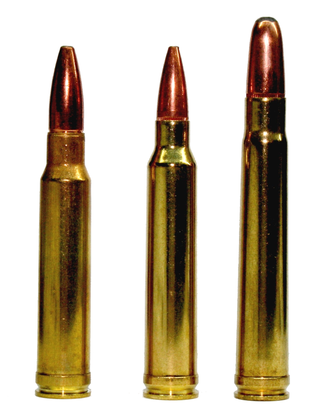
The .300 Winchester Magnum is a belted, bottlenecked magnum rifle cartridge that was introduced by the Winchester Repeating Arms Company in 1963. The .300 Winchester Magnum is a magnum cartridge designed to fit in a standard rifle action. It is based on the .375 H&H Magnum, which has been blown out, shortened, and necked down to accept a .30 caliber (7.62 mm) bullet.

The .444 Marlin (10.9×57mmR) is a rifle cartridge designed in 1964 by Marlin Firearms and Remington Arms. It was designed to fill in a gap left by the older .45-70 when that cartridge was not available in any new lever-action rifles; at the time it was the largest lever-action cartridge available. The .444 resembles a lengthened .44 Magnum and provides a significant increase in velocity. It is usually used in the Marlin 444 lever-action rifle. Currently, Marlin, who is now owned by Ruger Firearms, does not offer the .444 chambering in any of their rifles. It remains to be seen when or if they will bring the chambering back into production.

The .222 Remington or 5.7×43mm (C.I.P), also known as the triple deuce, triple two, and treble two, is a centerfire rifle cartridge. Introduced in 1950, it was the first commercial rimless .22 (5.56 mm) cartridge made in the United States. As such, it was an entirely new design, without a parent case. The .222 Remington was a popular target cartridge from its introduction until the mid-1970s and still enjoys a reputation for accuracy. It remains a popular vermin or "varmint" cartridge at short and medium ranges with preferred bullet weights of 40–55 grains and muzzle velocities from 3,000 to 3,500 ft/s (915–1,067 m/s).

The 7mm Remington Magnum rifle cartridge was introduced as a commercially available round in 1962, along with the new Remington Model 700 bolt-action rifle. It is a member of the belted magnum family that is directly derived from the venerable .375 H&H Magnum. The original purpose of the belted magnum concept taken from the .300 H&H Magnum and .375 H&H Magnum, was to provide precise headspace control, since the sloping shoulders, while easing cartridge extraction, were unsuitable for this purpose. Improved cartridge extraction reliability is desirable while hunting dangerous game, in particular when a fast follow-up shot is required. The 7mm Remington Magnum is based on the commercial .264 Winchester Magnum, .338 Winchester Magnum, and .458 Winchester Magnum, which were based on the same belted .300 H&H Magnum and .375 H&H Magnum cases, trimmed to nearly the same length as the .270 Weatherby Magnum.

The 6mm Remington rifle cartridge, originally introduced in 1955 by Remington Arms Company as the .244 Remington, is based on a necked down .257 Roberts cartridge using a .24/6mm bullet. Known for a combination of high velocity, long range, flat trajectory, and accuracy, it is suitable as a dual use hunting cartridge for both medium-sized big game and varmints. When used in the less common earlier slow twist barrels, it offers exceptional range for varmint applications. While not as commercially popular today as the .243 Winchester, the 6mm Remington enjoys a slight ballistic advantage and continues to be popular with handloaders and custom rifle builders.

The 8mm Remington Magnum belted rifle cartridge was introduced by Remington Arms Company in 1978 as a new chambering for the model 700 BDL rifle. The 8mm Remington Magnum's parent case is the .375 H&H Magnum. It is a very long and powerful cartridge that cannot be used in standard length actions, such as those that accommodate the .30-06 Springfield.
The .260 Remington cartridge was introduced by Remington in 1997. Many wildcat cartridges based on the .308 Winchester case had existed for years before Remington standardized this round.
The .17 Remington Fireball was created in 2007 by Remington Arms Company as a response to the popular wildcat round, the .17 Mach IV. Factory loads drive a 20 grain (1.3 g) bullet around 4,000 ft/s (1,219 m/s). Velocity is close to the .17 Remington but with significantly less powder, and therefore less heat and fouling. Both are important issues to high-volume shooters such as varmint hunters.
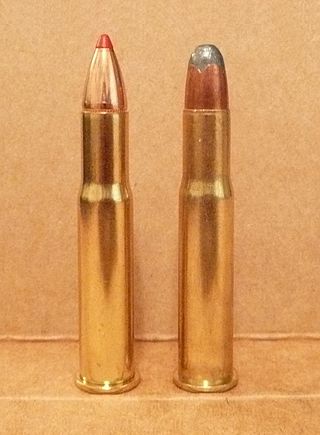
The .32 Winchester Special is a rimmed cartridge created in October 1901 for use in the Winchester Model 94 lever-action rifle. It is similar in name but unrelated to the .32-20 Winchester cartridge.
The 7-30 Waters cartridge was originally a wildcat cartridge developed by author Ken Waters in 1976 to give better performance to lever-action rifle shooters than the parent .30-30 Winchester cartridge, by providing a higher velocity and flatter trajectory with a smaller, lighter bullet. By 1984, Winchester introduced a Model 94 rifle chambered for the 7-30 Waters, establishing it as a commercial cartridge. In 1986, Thompson/Center began chambering 10-inch, 14-inch, and 20-inch Contender barrels for the cartridge.
The 6×45mm is a rimless, bottlenecked cartridge based on the .223 Remington or 5.56 NATO cartridge necked up to .243 (6mm). The cartridge is also known as the 6mm-223 Remington or 6mm/223.

A varmint rifle is a small-caliber precision firearm or high-powered airgun primarily used for both varmint hunting and pest control. These tasks include killing three types of pests or nuisance animals that spread diseases or destroy crops or livestock:

The .22 TCM or 22TCM is a proprietary bottle-necked rimless cartridge created from a 5.56mm NATO / 223 Rem parent case. Developed by custom gunsmith Fred Craig and Martin Tuason, President of Rock Island Armory (RIA) Armscor. Used in the RIA M1911 pistols, and the M22 TCM bolt-action rifle. Before the cartridge was commercialized, it was called the 22 Micro-Mag. Similar concept to other bottle-necked pistol cartridges such as 7.62x25mm Tokarev, and FN 5.7x28mm. The 22TCM trades bullet mass for increased velocity and lower recoil.
The .277 Wolverine (6.8x39mm) is a wildcat cartridge. It is a multi-purpose mid-power cartridge with increased ballistic performance over the AR-15's traditional .223 Remington cartridge. The use of a modified 5.56 case means that at minimum, only a new barrel is needed to convert any 5.56-based firearm to .277 Wolverine.

The 6mm Advanced Rifle Cartridge (6×38mm), or 6mm ARC for short, is a 6 mm (.243) caliber intermediate rifle cartridge introduced by Hornady in 2020, as a low-recoil, high-accuracy long-range cartridge, designed for use in the AR-15 platform at request of a specialized group within the U.S. DoD for its multipurpose combat rifle program.


